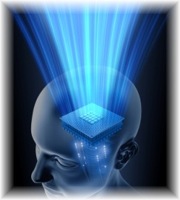Hypnosis
Hypnosis is a mental state (state theory) or set of attitudes and beliefs (non-state theory) usually induced by a procedure known as a hypnotic induction, which is commonly composed of a series of preliminary instructions and suggestions.[1] Hypnotic suggestions may be delivered by a hypnotist in the presence of the subject, or may be self-administered ("self-suggestion" or "autosuggestion"). The use of hypnotism for therapeutic purposes is referred to as "hypnotherapy".
The words 'hypnosis' and 'hypnotism' both derive from the term "neuro-hypnotism" (nervous sleep) coined by the Scottish surgeon James Braid around 1841. Braid based his practice on that developed by Franz Mesmer and his followers ("Mesmerism" or "animal magnetism"), but differed in his theory as to how the procedure worked.
Contrary to a popular misconception - that hypnosis is a form of unconsciousness resembling sleep - contemporary research suggests that it is actually a wakeful state of focused attention[2] and heightened suggestibility,[3] with diminished peripheral awareness.[4] In the first book on the subject, Neurypnology (1843), Braid described "hypnotism" as a state of physical relaxation accompanied and induced by mental concentration ("abstraction").
Characteristics
Skeptics point out the difficulty distinguishing between hypnosis and the placebo effect, proposing that hypnosis is so heavily reliant upon the effects of suggestion and belief that it would be hard to imagine how a credible placebo control could ever be devised for a hypnotism study.[6]
It could be said that hypnotic suggestion is explicitly intended to make use of the placebo effect. For example, Irving Kirsch has proposed a definition of hypnosis as a "non-deceptive mega-placebo," i. e., a method which openly makes use of suggestion and employs methods to amplify its effects.[citation needed]
Definitions
The earliest definition of hypnosis was given by Braid, who coined the term "hypnotism" as an abbreviation for "neuro-hypnotism", or nervous sleep, which he opposed to normal sleep, and defined as:
a peculiar condition of the nervous system, induced by a fixed and abstracted attention of the mental and visual eye, on one object, not of an exciting nature.[7]
Braid elaborated upon this brief definition in a later work:
[...] the real origin and essence of the hypnotic condition, is the induction of a habit of abstraction or mental concentration, in which, as in reverie or spontaneous abstraction, the powers of the mind are so much engrossed with a single idea or train of thought, as, for the nonce, to render the individual unconscious of, or indifferently conscious to, all other ideas, impressions, or trains of thought. The hypnotic sleep, therefore, is the very antithesis or opposite mental and physical condition to that which precedes and accompanies common sleep [...][8]
Braid therefore defined hypnotism as a state of mental concentration which often led to a form of progressive relaxation termed "nervous sleep". Later, in his The Physiology of Fascination (1855), Braid conceded that his original terminology was misleading, and argued that the term "hypnotism" or "nervous sleep" should be reserved for the minority (10%) of subjects who exhibited amnesia, substituting the term "monoideism", meaning concentration upon a single idea, as a description for the more alert state experienced by the others.
A new definition of hypnosis, derived from academic psychology, was provided in 2005, when the Society for Psychological Hypnosis https://en.wikipedia.org/wiki/American_Psychological_Association, Division 30 of the American Psychological Association (APA), published the following formal definition:
Hypnosis typically involves an introduction to the procedure during which the subject is told that suggestions for imaginative experiences will be presented. The hypnotic induction is an extended initial suggestion for using one's imagination, and may contain further elaborations of the introduction. A hypnotic procedure is used to encourage and evaluate responses to suggestions. When using hypnosis, one person (the subject) is guided by another (the hypnotist) to respond to suggestions for changes in subjective experience, alterations in perception, sensation, emotion, thought or behavior. Persons can also learn self-hypnosis, which is the act of administering hypnotic procedures on one's own. If the subject responds to hypnotic suggestions, it is generally inferred that hypnosis has been induced. Many believe that hypnotic responses and experiences are characteristic of a hypnotic state. While some think that it is not necessary to use the word "hypnosis" as part of the hypnotic induction, others view it as essential.
Details of hypnotic procedures and suggestions will differ depending on the goals of the practitioner and the purposes of the clinical or research endeavor. Procedures traditionally involve suggestions to relax, though relaxation is not necessary for hypnosis and a wide variety of suggestions can be used including those to become more alert. Suggestions that permit the extent of hypnosis to be assessed by comparing responses to standardized scales can be used in both clinical and research settings. While the majority of individuals are responsive to at least some suggestions, scores on standardized scales range from high to negligible. Traditionally, scores are grouped into low, medium, and high categories. As is the case with other positively-scaled measures of psychological constructs such as attention and awareness, the salience of evidence for having achieved hypnosis increases with the individual's score.[9]
References
- "New Definition: Hypnosis" Division 30 of the American Psychological Association [1]
- "Information for the Public. American Society of Clinical Hypnosis."
- Lyda, Alex. "Hypnosis Gaining Ground in Medicine." Columbia News
- p. 22, Spiegel, Herbert and Spiegel, David. Trance and Treatment. Basic Books Inc., New York. 1978. ISBN 0-465-08687-X
- Braid, J. (1843) Neurypnology.
- Bausell, R Barker, quoted in The Skeptic's Dictionary
- Braid, Neurypnology, 1843: 'Introduction'
- Braid, Hypnotic Therapeutics, 1853
- "New Definition: Hypnosis" Society of Psychological Hypnosis Division 30 - American Psychological Association.
